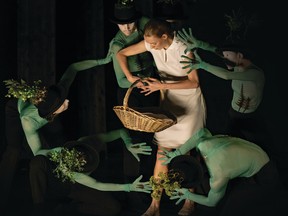
Reviews and recommendations are unbiased and products are independently selected. Postmedia may earn an affiliate commission from purchases made through links on this page.
Article content
While russian composer Igor Stravinsky’s score for his ballet The Rite of Spring is now considered an avant-garde classic; Its reception in 1913 was not very enthusiastic. In fact, he was downright hostile and reportedly caused a near riot on opening night in Paris.
In fact, the reaction was so bad that it appears in an entry on a surprisingly comprehensive Wikipedia page called “List of classical music concerts with rebellious audience response.”
Advertisement 2
Article content
Article content
The Rite of Spring is part of Alberta Ballet’s late-season double bill along with Der Wolf, a 2021 version of the choreographer’s Little Red Riding Hood. Morgann Runacre-Temple premiered at the Graz Opera in Austria. The Rite of Spring is no longer controversial, of course, and Stravinsky’s score is possibly one of the main reasons the piece is revered 111 years after its creation.
“It created a lot of different feelings and different approaches,” says Alberta Ballet artistic director Francesco Ventriglia. “But it is a masterpiece. It’s obviously still here. It is probably one of the best scores written in the last century. Fortunately, some people in art and culture want to be revolutionary and give us masterpieces that can survive over time.”
This is Alberta Ballet’s season finale and was actually programmed by Ventriglia’s predecessor, Christopher Anderson. But Ventriglia, who became artistic director in December, is familiar with the piece because he participated in more than 50 performances when he was a young dancer in Milan. Alberta Ballet will base its version on Nicolo Fonte’s 2014 choreography, a new adaptation that nevertheless maintains the dark, surreal power of the original.
Article content
Advertisement 3
Article content
While Der Wolf may be equally dark (Alberta Ballet warns audiences about the double bill’s adult themes and theatrical depictions of abuse, violence and death), the two productions are very different. The Rite of Spring tells an abstract story of rebirth, but it has much less narrative basis than Der Wolf.
“For Nicolo Fonte, the choreographer, when I spoke to him he told me: ‘My driving force was really the music, I didn’t want to get too much into the narrative, I really wanted to use the score and create this vocabulary of movement to express the different colors of the score’: says Ventriglia. “I have to say that when I walked into the studio, it was very powerful. Ballet is very physical, there is very acrobatic lifting with the girls. The dancers are flying. “It’s really powerful.”
Der Wolf, on the other hand, has Runacre-Temple reinvents the tale of Little Red Riding Hood giving it three different endings and a contemporary feel.
“It’s more theatrical,” he says. “It is very strong, it is based on contemporary movement but has a theatrical approach. The fun thing is that it basically tells us the story of Little Red Riding Hood three times with three different endings. It’s about ‘what if?’ What if the wolf does this? What if Little Red Riding Hood reacted this way? You see the story begin and end three times with a different ending.”
Advertisement 4
Article content
Perhaps not surprisingly, Der Wolf reinvents Little Red Riding Hood, making her less of a victim.
“I think it’s very interesting to go back to fairy tales and see how we can read them again and understand a different side of the story,” she says. “I think Morgan, with this idea of repeating the story three times with a different ending, gives power to Little Red Riding Hood because every time the story begins again Little Red Riding Hood is older and then she is beginning to be a woman, she is beginning. Be a woman and start making your own decisions. I love the character growth and character empowerment. “She’s not just a little girl running through the woods.”
The production of Der Wolf and The Rite of Spring not only closes a chapter at Alberta Ballet (Ventriglia is expected to announce the company’s inaugural season lineup next week), but it will also be the final farewell to none other than seven dancers at Alberta Ballet. Twin sisters Jennifer and Alexandra Gibson announced last month that it would be their last show after 15 years with the company. Principal dancer Heather Dornian; senior corps de ballet dancers Eli Barnes, Melissa Eguchi and Kira Anderson; and corps de ballet dancer Mya Kresnyak will also retire after performing in Der Wolf and the Rite of Spring.
Advertisement 5
Article content
There will be an international audition tour for new members of Alberta Ballet, although auditions will begin in Calgary. Forty-eight hours after Alberta Ballet announced auditions, there were 350 applications. Auditions will also be held in Milan, London and New York, he says.
While it is bittersweet and even “painful” to see experienced dancers leave Alberta Ballet, Ventriglia says he understands the artists’ desire to do something different with their lives. Ballet, she says, encompasses everything.
“This is a very fragile art form that requires every piece of you from the age of 7 or 8 and throughout your life,” he says. “You give everything to this art: you give it your childhood, you give it your (adolescence), you give it every phase of your life. You’re in the studio working hard. So I totally understand that if you get to a certain point in your life and you want a different chapter, you want a change. So I’m here to support you and to make sure your final bow is special. “I will make sure they are honored and thanked as they deserve and every artist deserves.”
Der Wolf and the Rite of Spring will be performed in at the Southern Alberta Jubilee Auditorium in Calgary from May 2-4 and at the Northern Alberta Jubilee Auditorium in Edmonton from May 10-11.
Article content
